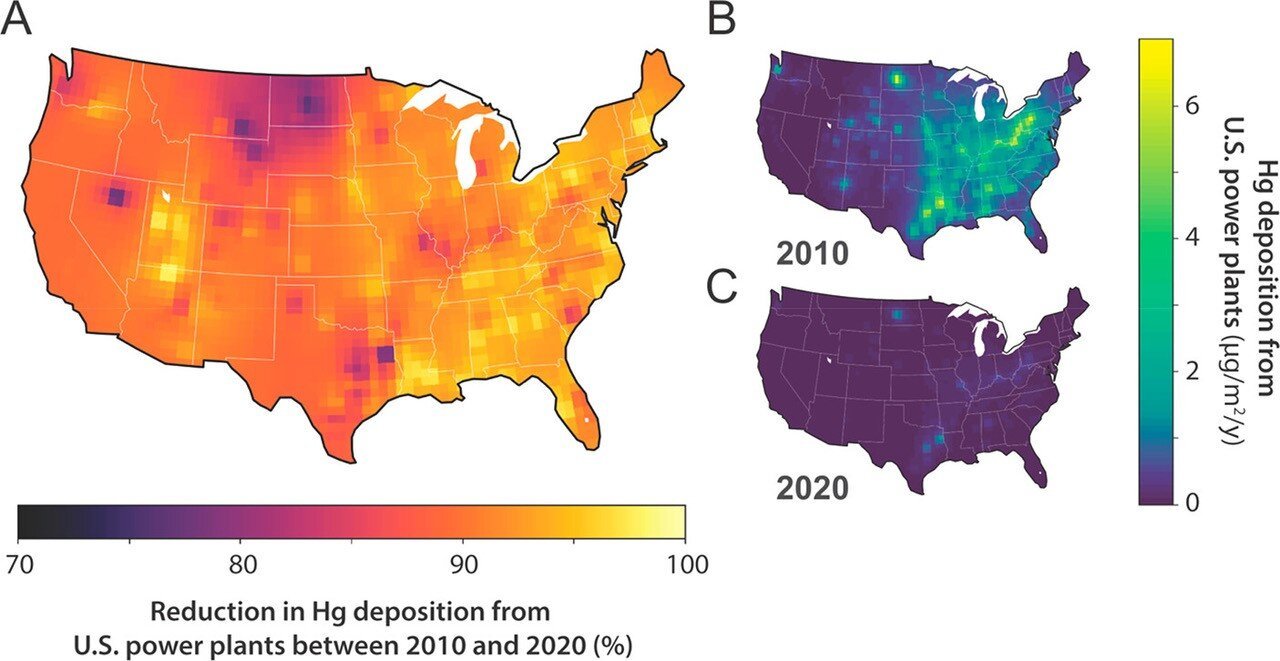The remarkable success of the federal government’s prominent environmental laws is often overlooked in partisan political debates concerning regulations impacting the energy sector. One such example is the U.S. Environmental Protection Agency’s Mercury and Air Toxics Standards (MATS), which aimed to reduce hazardous air pollutant (HAP) emissions from fossil fuel-fired power plants.
According to a recent study conducted by the Harvard John A. Paulson School of Engineering and Applied Sciences (SEAS), the implementation of MATS resulted in a staggering 90% decrease in mercury emissions from U.S. power plants over a decade. This reduction in mercury emissions is crucial as mercury is a highly toxic substance that can adversely affect the nervous system and has been linked to increased risks of fatal heart attacks in adults. Furthermore, the study examined the sociodemographic disparities in mercury exposure and identified residual risks that persist for populations with the highest levels of exposure.
Before the introduction of MATS in 2011, coal-fired power plants constituted the largest domestic source of mercury emissions. In 2005, these plants accounted for 50% of all primary mercury emission sources in the United States. By enforcing stringent emissions control standards nationwide, MATS compelled power plant operators to adopt measures to meet these standards. As a result, many operators opted to retire their coal-fired electricity generation units entirely, especially when the cost of natural gas declined. Some facilities even transitioned to burning natural gas, a fuel source that emits negligible amounts of mercury. Out of the 507 coal-fired power plants operating in 2010 prior to the implementation of MATS, 230 were completely retired, and 62 were partially retired by 2020.
It is crucial to recognize and appreciate the effectiveness of environmental regulations like MATS in mitigating harmful emissions and safeguarding public health. By acknowledging these successes, we can have a more informed and constructive discourse on energy sector regulations, transcending partisan divisions. The findings of the Harvard SEAS study provide valuable insights into the positive impact of such regulations while highlighting areas that require continued attention to address remaining risks for vulnerable populations.
“The success of the MATS regulation is yet another remarkable achievement linked to the Clean Air Act Amendments of 1990,” remarked Elsie Sunderland, who holds the position of Fred Kavli Professor of Environmental Chemistry and Professor of Earth and Planetary Sciences at SEAS. She further added, “This regulation has effectively eliminated the majority of the remaining mercury emissions point sources in the United States, providing benefits to millions of freshwater and recreational anglers nationwide.”
Despite significant progress made on a national level, two regions, Texas and North Dakota, continue to be persistent sources of mercury emissions. These states are home to power plants that burn locally mined lignite coal, which is a lower-quality and less dense energy source compared to the bituminous coal used in most other parts of the country. Consequently, the control standards for mercury emissions from lignite burning in 2012 were less stringent, resulting in higher mercury emissions compared to other areas even after the implementation of the MATS rule.
To address this issue, the Environmental Protection Agency (EPA) is obligated to periodically assess whether advancements in technology warrant updates to the existing standards. The EPA has now proposed changes to the MATS rule, which would require operators of lignite coal-burning power plants to adopt technologies that significantly reduce toxic emissions. These proposed stricter standards are currently open for public comment until June 23, 2023.
“Our recent research indicates that strengthening the MATS rule, as proposed by the Biden Administration, would eliminate the last two remaining hotspots of mercury deposition in the United States associated with coal-fired power plants. This is a crucial change that will bring benefits to vulnerable communities and indigenous groups,” Sunderland explained.
It is important to recognize the significance of these proposed amendments and actively participate in the public comment process to support further improvements in the regulation. By strengthening the MATS rule, the United States can take significant strides in reducing mercury emissions and protecting the well-being of communities and ecosystems across the country.
The research team from Harvard also delved into the sociodemographic aspects of individuals residing near power plants that were still in operation by 2020, as compared to those living near plants that had been retired since 2010. Their findings revealed that individuals who continue to face hazardous mercury exposure from power plant emissions are often from socioeconomically disadvantaged backgrounds, with lower levels of education, and belonging to households where English proficiency is limited.
Mona Dai, a Ph.D. student in Professor Sunderland’s Lab and the lead author of the study, emphasized the significance of these findings, stating, “This research highlights the inequitable distribution of pollution sources and exposures in the United States, with detrimental effects on the health of the most vulnerable individuals and communities.”
The study’s additional authors include Benjamin Geyman and Colin Thackray from SEAS, along with Xindi Hu from Mathematica, Inc., contributing to the comprehensive analysis of sociodemographic disparities in mercury exposure and the associated environmental justice implications.
Source: Harvard John A. Paulson School of Engineering and Applied Sciences

